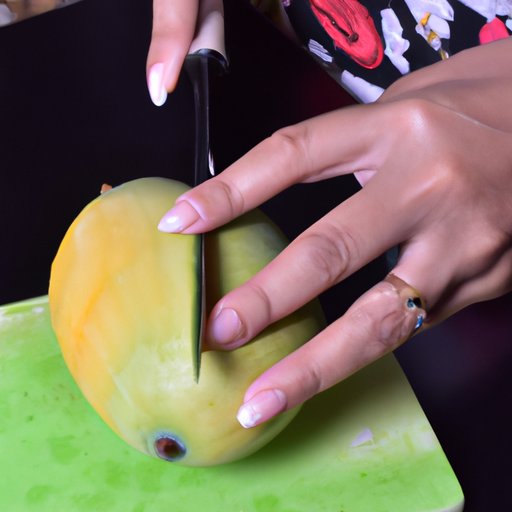
Introduction
Mango is a delicious fruit enjoyed by many – sweet, juicy, and versatile. Whether you enjoy it straight out of your hand or use it to make a delicious recipe, learning how to properly cut a mango is important. In this article, we will provide you with a step-by-step guide, recipes, and nutritional information to make mango cutting easy and beneficial for you.
Step-by-Step Guide
To cut a mango, you will need a sharp knife, a cutting board, and a ripe mango. First, rinse the mango with water to remove any dirt or debris. Then, hold the fruit steady on the cutting board with one hand. With the other hand, slice off each flat side of the mango to get two halves. Be sure to cut around the long, flat seed in the center.
Next, score the flesh inside each half in a crosshatch pattern, being careful not to cut through the skin. Use a spoon to scoop out the mango cubes, or if you’re feeling confident, carefully flip the skin inside-out and slice the cubes off with your knife.
Recipe with Mango
Mango can be used in a variety of recipes, from smoothies to salsas. For a simple yet delicious recipe that incorporates mango, try making a Mango Salsa. First, dice one ripe mango and add to a mixing bowl. Then, add one diced red bell pepper, one diced jalapeño, one diced red onion, and a handful of chopped cilantro. Finally, drizzle with the juice of one lime and stir to combine. Serve with tortilla chips or over fish or chicken.
To properly cut the mango for the salsa, follow the instructions in the previous section, Step-by-Step Guide.
Benefits of Eating Mango
In addition to being delicious, mango offers many nutritional benefits. One cup of diced mango contains roughly 100 calories, 2.6 grams of fiber, and 100% of your daily vitamin C. It is also rich in vitamin A, potassium, and beta-carotene. Mango is known for aiding digestion, boosting immunity, and promoting healthy skin and eyes. To enjoy the benefits, make sure to incorporate mango into a healthy and balanced diet.
Mango Varieties
Mangoes come in many varieties, each with its own unique flavor and texture. The most common varieties include Alphonso, Ataulfo, and Kent. Alphonso mangoes are known for their sweet flavor and smooth texture, while Ataulfo mangoes are smaller and sweeter with a creamy texture. Kent mangoes are the most widely grown in the United States and are larger with a mild, sweet flavor.
When cutting different types of mangoes, keep in mind that some varieties have thicker skin or larger pits. Refer to the Step-by-Step Guide for general instructions and use your best judgement when cutting each type of mango. When selecting mangoes, look for fruit that is fragrant, slightly soft to the touch, and blemish-free. You can also ripen underripe mangoes at home by storing them in a paper bag at room temperature for a few days.
Mango Preservation
If you have leftover cut mango, there are several ways to preserve it for later use. First, you can freeze it by placing the mango cubes on a baking sheet in a single layer and freezing for a few hours. Once frozen, transfer the cubes to an airtight container and store in the freezer for up to six months. You can also can ripe mangoes and store them in the pantry for up to a year.
To store cut mango in the refrigerator, place the cubes in an airtight container or resealable bag and store in the fridge for up to five days. For optimal freshness, avoid storing cut mango at room temperature for more than two hours.
Conclusion
Cutting a mango might seem daunting, but with our step-by-step guide, you’ll be a pro in no time. Whether you enjoy it on its own or use it in one of our delicious recipes, mango is a tasty and nutritious fruit worthy of a spot in any kitchen.




